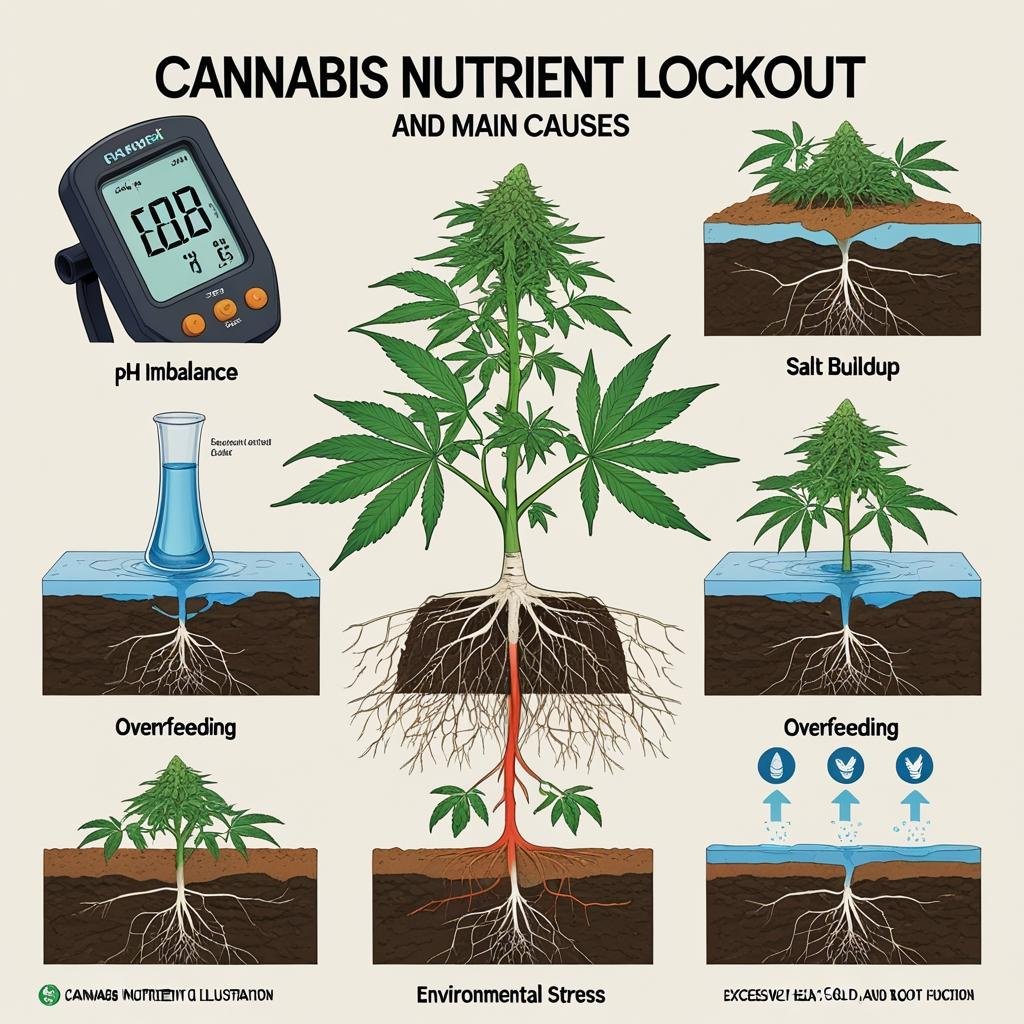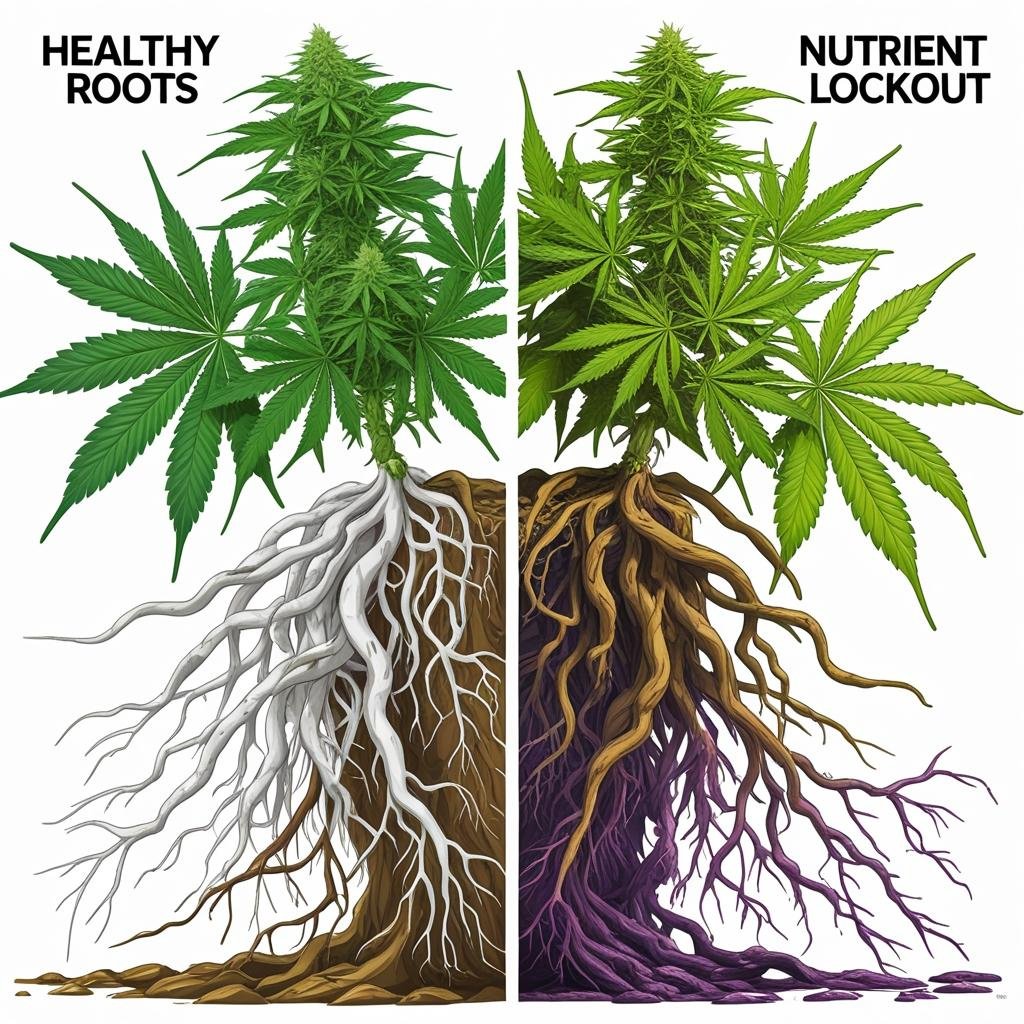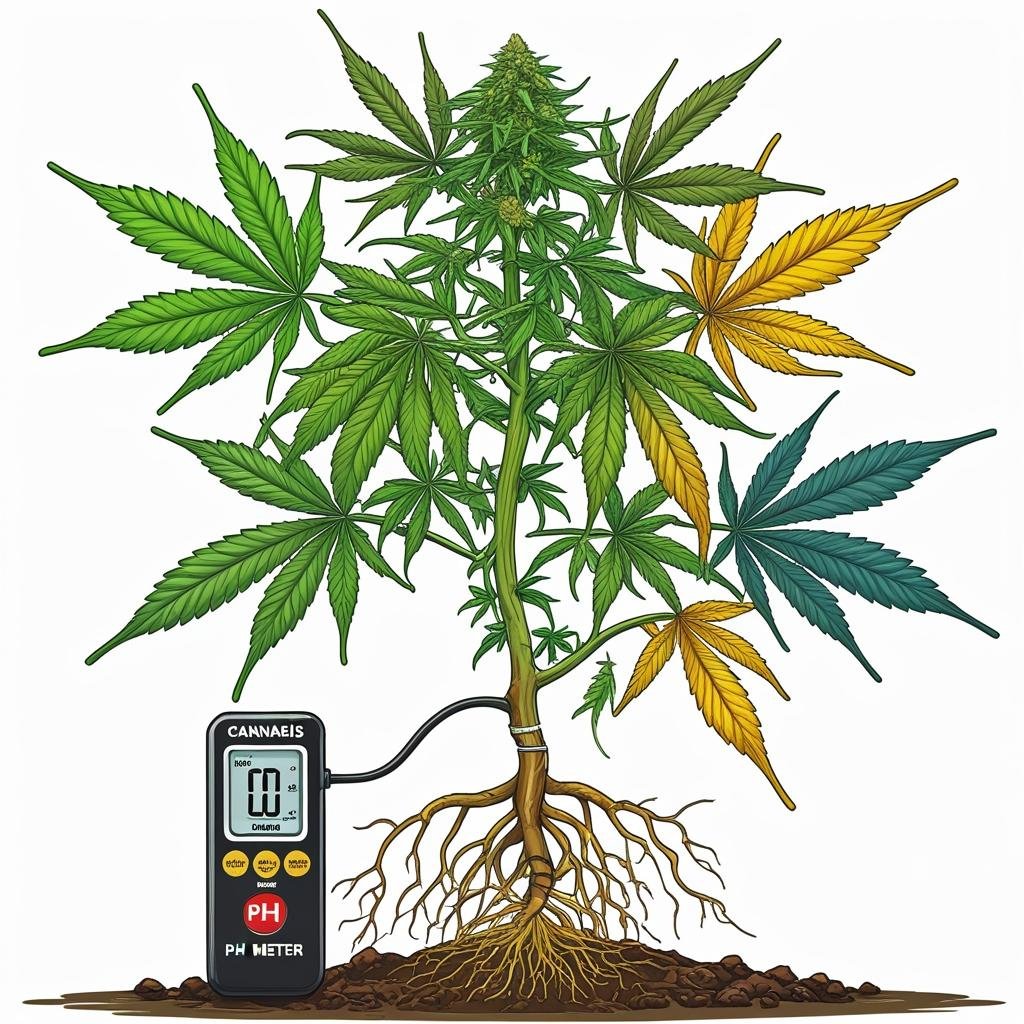Every cannabis grower has faced the gnawing frustration of nutrient lockout, those once-vibrant plants suddenly slowing down, showing discoloration, and refusing to respond no matter how perfectly you dial in your feeding routine.
If your instinct is to add more nutrients, stop right there.
Often, the real culprit isn’t nutrient deficiency but nutrient lockout.
Nutrient lockout happens when your plant’s roots simply cannot absorb the nutrients you’ve provided. Despite being surrounded by the very minerals they need to thrive, the roots go on strike, turning your feeding program into a wasted investment. You must be prepared to deal with nutrient lockout to avoid stunted growth, unhealthy foliage, and a disappointing harvest.
Let’s explore everything there is to know about nutrient lockout and how to prevent and fix it the right way.
What Is Nutrient Lockout?
Nutrient lockout occurs when a cannabis plant is surrounded by all the necessary nutrients, but due to chemical or physical barriers at the root zone, it cannot absorb them.
This results in your plants exhibiting all the classic symptoms of deficiencies, while hidden salt buildup or pH swings are actually to blame. It’s heartbreaking when you pour love and nutrients into your grow, expecting reward, but instead watch their leaves yellow, crinkle, or drop.
The Telltale Signs Your Plants Are Locked Out
Before you misdiagnose the situation as a deficiency and ramp up your feeding, slow down and look at the overall picture.
Nutrient lockout manifests as widespread distress.
Lower leaves often yellow first, then rusty or purple blotches may creep across the foliage, and stems may start to redden or turn a dull purplish hue. New growth may look stunted or malformed, and the plant’s vigor will be sapped away. The most infuriating part is that, on paper, your nutrient solution appears flawless.
What sets lockout apart from a true deficiency is that symptoms often appear even though you’ve been feeding, sometimes aggressively, and nothing seems to remedy the situation. Worse, adding more nutrients on top of the issue usually causes it to spiral, as those extra minerals further invigorate the imbalance at the root zone.
The Real Triggers Behind Nutrient Lockout
Nutrient lockout doesn’t strike at random. The vast majority of lockout problems can be traced back to a handful of core causes. Perhaps the most significant culprit is pH imbalance.
Each essential nutrient in your feed needs a particular pH range to remain chemically available to your roots. Slip too far outside that comfort zone—too acidic or too alkaline—and nutrients precipitate out, transforming into forms the roots simply can’t absorb. It doesn’t matter how much you provide; your roots aren’t interested in food they can’t digest.
Salt buildup is another common perpetrator.
Over time, leftover nutrients that the plant hasn’t taken up accumulate in the growing medium, especially if you’re using mineral-based feeds. These salts can overwhelm the roots, drawing water out and preventing essential minerals from entering through the roots’ membranes. This results in a root zone that’s saturated, but toxic and impenetrable for the plant.

Sometimes, the problem is rooted in overfeeding or underfeeding, though the majority of cases stem from giving too much rather than too little. When you bombard your plants with excessive nutrients, they simply can’t keep up; instead, salts pile up, and the plant’s absorption slows down in self-defense.
Watering practices come next in the list of suspects.
Overwatered pots smother roots, robbing them of oxygen and leaving them vulnerable to rot and compaction. This, in turn, damages the root hairs responsible for nutrient uptake. On the other hand, if your medium dries out completely, nutrients cannot dissolve and move towards the roots, resulting in lockout-like symptoms again. Somewhere in between, with a moist but well-drained root zone, cannabis plants find their sweet spot.
Environmental factors amplify these issues. Excessive heat, extreme cold, or sudden humidity shifts can all stress root function and force the plant into survival mode, reducing its ability to absorb nutrients, no matter their availability in grow medium.
Diagnosing Nutrient Lockout With Confidence
As a grower, you should be able to diagnose and save your plants from nutrient lockout. It’s a common problem, and you must be ready to unhook your plants from it when it happens. It’s a skill you must have because (from my experience) you’ll need it from time to time given that most factors contribute to it.
The first step to diagnosing nutrient lockout is to assess your feeding habits. Ask yourself this question: Have I been feeding correctly, and these symptoms still emerged? If so, your attention should shift towards pH and salt buildup, rather than your feeding frequency.
Test your runoff or soil solution’s pH to get the clearest hint.
If the reading falls well outside the recommended range—which sits at 6.0 to 6.5 in soil and 5.5 to 6.5 for hydro or coco—it’s time to take corrective action.
Measuring the electrical conductivity (EC) or parts per million (PPM) in your runoff is equally important. Suspiciously high levels almost always indicate a salt buildup in the pot, which must be dealt with if you want your plants to start feeding again.
Don’t overlook the physical condition of your roots either: healthy roots should be white and fuzzy. Any sign of browning, slime, or a funky odor indicates root injuries or disease, which will always result in poor nutrient uptake.

Also, review your recent practices, especially if you’ve changed nutrient brands, added powerful boosters, or adjusted your environment. Lockout often sets in after well-intentioned but poorly timed adjustments.
What’s The Right Way to Fix Nutrient Lockout?
After diagnosing your plant for nutrient lockout, the worst thing you can do now is continue to dump nutrients in desperation. Your priority should be to restore the plant to a state where it can feed again, and that means clearing away what’s blocking its roots.
Begin by flushing your medium thoroughly with clean, pH-balanced water.
This process can feel dramatic, but it’s essential. Not only will you be washing away excess salts, but you’re resetting the root environment. For soil, this involves slowly pouring at least three times the pot’s volume of water through the medium, ensuring the runoff is well-draining and clear.
In hydroponic systems, a change of reservoir water paired with gentle flushing agents can perform the same function. Don’t rush through this step; results depend on patience and thoroughness.
With the medium flushed, resist the temptation to feed right away. Allow your plants to rest, watering only as needed with pH-corrected plain water for a few days. Keep an eye out during this period; new growth should become more vibrant, and symptoms should begin to subside.
Once recovery is underway and your roots have had a chance to rest, reintroduce your nutrients in small portions.Start with a quarter to half of your usual dosage, ensuring your pH is right in the target window.
Observe for signs of renewed vigor and only ramp up the feeding rate as your plants demand it, not before.
If your roots suffered, this is the ideal time to introduce root-boosting supplements or beneficial microbes. Mycorrhizal inoculants and similar products help re-establish healthy root colonies, which are critical for long-term nutrient uptake.
Preventing Nutrient Lockout in Future Grows
Once you’ve rescued your plants, prevention needs to be at the heart of your grow philosophy. It all starts and ends with pH management. Test every tank, reservoir, and watering can, and calibrate your instruments regularly to ensure accuracy.
Don’t settle for cheap pens. Accuracy can mean the difference between bountiful buds and withered leaves at harvest.
Understand your water source. Hard tap water often contains excessive amounts of calcium and magnesium. Check your local supply and supplement only as needed, avoiding overdosing with calcium and magnesium, which can also contribute to salt buildup.
Feeding should be a conversation, not a monologue.
Let your plants tell you what they need.
Start lower on the nutrient charts than you might feel is necessary, and gradually increase only if growth is robust and healthy. Remember, cannabis can flourish on remarkably moderate feeds when all other parameters are dialed in.
Pay attention to watering. Allow the medium to just dry at the surface between waterings. Consistent, moderate cycles keep the roots thriving and the plant happy. Regular flushing, especially in soil and coco, is a fantastic insurance policy. It only takes a few minutes every few weeks but can save your crop from disaster.
Don’t forget to manage your climate. Stable temperatures and consistent humidity help plants regulate their metabolism and prevent wide fluctuations that challenge nutrient absorption. A healthy environment means healthy, active roots and better nutrient uptake.
Conclusion
Nutrient lockout will test your patience, skill, and commitment as a grower, but it’s entirely preventable and 100 percent fixable if you respond quickly.
Be vigilant and keep your pH levels tight. Flush and monitor your root zone, and listen to your plant’s feedback instead of just relying on the feeding chart. The difference between a disappointing crop and a harvest of dense, fragrant, resin-dripping buds often comes down to your ability to catch and address this hidden affliction before it does permanent harm.
For more expert cannabis grow advice, keep following Weedmania420. We’re here to make sure your plants never miss a meal again and your stash jars are always overflowing.

